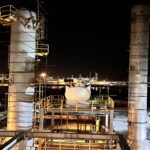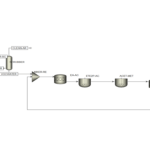Introduction
Dynamic simulation in chemical processes using Aspen Plus is a powerful tool used to simulate the time-dependent behavior of chemical processes. Unlike steady-state simulations, which provide information at a single point in time, dynamic simulations provide insights into how a system responds to changes over time, such as disturbances, startup/shutdown methods, and control system interactions.
Choosing the right thermodynamic models as a starting point for the correct simulation of a process is very important. Choosing a thermodynamic model is one of the first necessary steps in simulation. These models usually include multi-parameter models (EOS), activity models (solutions), vapor pressure models and other specialized models to consider non-ideality in gas and liquid mixtures.
Description of the process
“We begin with a converged steady-state model in Aspen Plus. All equipment, thermodynamic properties, and flow characteristics must be carefully defined. Once the steady-state simulation is complete, we transition the model to Aspen Plus Dynamics using built-in tools. This step involves sizing equipment, control volumes, and establishing initial pressure-flow relationships.
By specifying operating conditions and implementing control systems like PID controllers, we configure the dynamic model. Next, we define dynamic events such as changes in feed flow, temperature variations, valve opening/closing, equipment start/stop, or disturbances. To observe the system’s response to these imposed dynamic changes, we simulate the process for a specific time range. We examine the time profiles of various process variables (temperature, pressure, flow, etc.) and assess the system’s performance, stability, and control.”

Conclusion
Dynamic simulation with Aspen Plus is a powerful tool for analyzing and optimizing chemical processes. This tool allows chemical engineers to understand the complex behavior of systems and make better decisions for the design, control and operation of processes.
Dynamic simulation in chemical processes with Aspen Plus
In this project, dynamic simulation in chemical processes is simulated in Aspen Plus software. The project has partial training. To buy the project or get more information about it, proceed through the link below.


